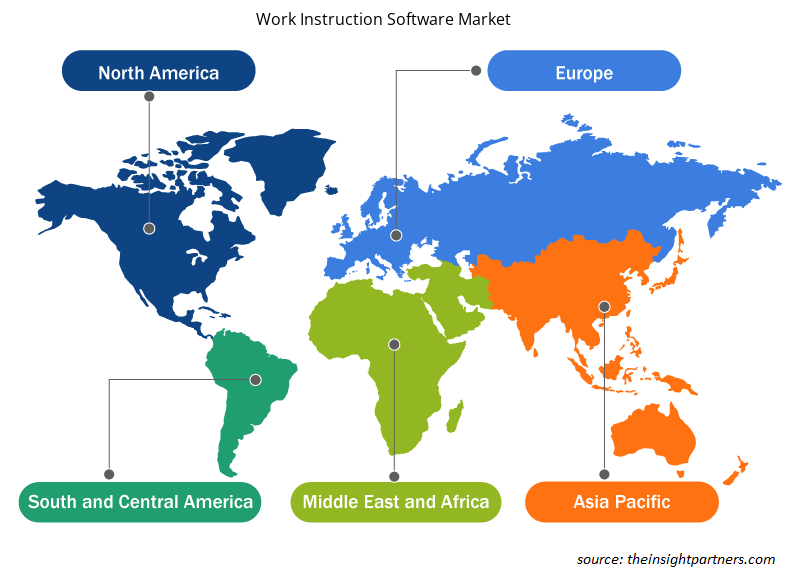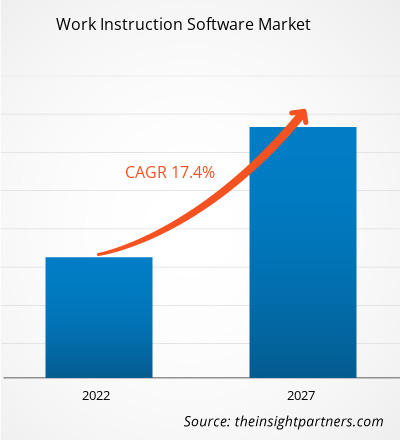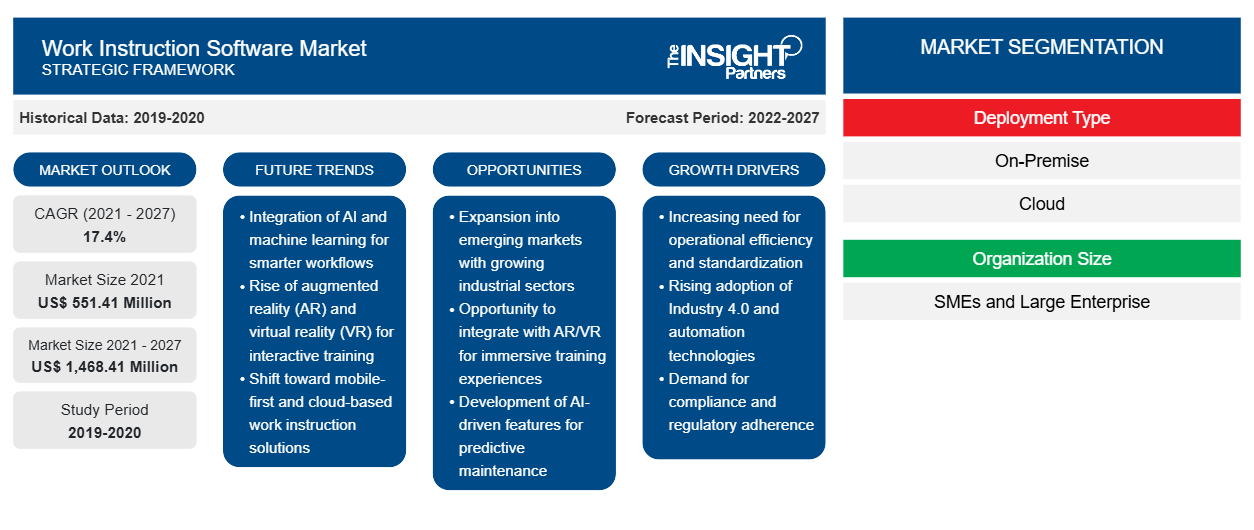Se espera que el mercado de software de instrucciones de trabajo crezca de US$ 551,41 millones en 2021 a US$ 1.468,41 millones en 2027. Se espera que el mercado de software de instrucciones de trabajo crezca a una CAGR del 17,4% durante el período de pronóstico de 2020 a 2027.
El factor clave que impulsa el mercado es la complejidad empresarial y de producción en constante cambio. La adopción de un proceso de producción de modelos mixtos para mejorar la productividad de fabricación de la organización en general está creando la necesidad de una mejor capacitación y desarrollo entre los empleados. Esto, por lo tanto, está impulsando la adopción de software de instrucciones de trabajo en todo el sector manufacturero. La necesidad de capacitación de los empleados para mejorar la productividad está llevando a la adopción de soluciones tecnológicamente avanzadas en todas las empresas. La mayor complejidad del proceso de trabajo en industrias como la fabricación, la automoción, la atención médica y el comercio minorista está aumentando la demanda de instrucciones de trabajo entre los empleados y los trabajadores para realizar su tarea de forma independiente y eficiente. Por ejemplo, Augmentir, Inc. ofrece una plataforma de fuerza laboral conectada impulsada por inteligencia artificial para ayudar a los empleados con flujos de trabajo digitales y orientación remota durante todo el proceso de trabajo.
Con la propagación de la pandemia de COVID-19 por todo el mundo, se está haciendo evidente que pocos pueden escapar de su alcance, lo que presenta desafíos significativos para todas las industrias. Sin embargo, la principal aplicación del software es en el sector manufacturero, donde se aplica para impartir capacitación a los empleados sobre el funcionamiento de ciertas maquinarias. Por lo tanto, se espera que el cierre de todas las unidades de fabricación en los países desarrollados y en desarrollo afecte negativamente al crecimiento del mercado de software de instrucción laboral .
Según el tipo de implementación, el software de instrucciones de trabajo se segmenta en local y en la nube. Se espera que las soluciones basadas en la nube crezcan con la CAGR más alta durante el período de pronóstico. Además, el mercado de software de instrucciones de trabajo según el tamaño de la organización se segmenta en pymes y grandes empresas. Las grandes empresas representaron la mayor participación en el mercado. El mercado global de software de instrucciones de trabajo se ha segmentado en cinco regiones principales: América del Norte, Europa, APAC, MEA y SAM.
Personalice este informe según sus necesidades
Obtendrá personalización en cualquier informe, sin cargo, incluidas partes de este informe o análisis a nivel de país, paquete de datos de Excel, así como también grandes ofertas y descuentos para empresas emergentes y universidades.
-
Obtenga las principales tendencias clave del mercado de este informe.Esta muestra GRATUITA incluirá análisis de datos, desde tendencias del mercado hasta estimaciones y pronósticos.
Perspectivas del mercado del software de instrucciones de trabajo
Cambio de la cultura laboral en toda la organización
La creciente tendencia de Bring Your Own Device (BYOD) junto con la cultura de trabajo remoto en las organizaciones, especialmente en las grandes empresas, está creando la necesidad de soluciones de instrucción laboral para garantizar el funcionamiento sin problemas dentro de la organización. La cultura de trabajo flexible en las organizaciones ha llevado a la no presencia de empleados en las oficinas, lo que provoca interrupciones en el flujo de trabajo, especialmente para los empleados de nivel junior que requieren asistencia continua para aprender y ejecutar trabajos para la adquisición de objetivos. La integración de soluciones de instrucción laboral en las organizaciones permite a los empleadores instruir a todos los empleados sin dejar que la barrera física afecte la eficiencia de la producción.
Información del mercado basada en el tipo de implementación
Según el tipo de implementación, el mercado mundial de software de instrucciones de trabajo se segmenta en implementación basada en la nube y en las instalaciones. El software de instrucciones de trabajo basado en la nube está experimentando una gran demanda en comparación con el software de instrucciones de trabajo en las instalaciones. El segmento de la nube genera la mayor parte de la demanda, ya que es comparativamente menos costoso y debido a la sólida infraestructura de red en los países desarrollados. Además, los proveedores de software de instrucciones de trabajo basado en la nube están muy centrados en el desarrollo de un parche de seguridad de alto nivel para eliminar el riesgo de ciberataques. Este factor también está creando una demanda significativa de los usuarios finales, lo que impulsa el mercado de software de instrucciones de trabajo.
Perspectivas del mercado basadas en el tamaño de las organizaciones
Según el tamaño de la organización, el mercado de software de instrucciones de trabajo se segmenta en pymes y grandes empresas. La creciente inversión en infraestructura de fabricación tanto en países desarrollados como en desarrollo está impulsando significativamente la demanda de software de instrucciones de trabajo entre las pymes.
Los actores que operan en el mercado de software de instrucciones de trabajo se centran en estrategias, como iniciativas de mercado, adquisiciones y lanzamientos de productos, para mantener sus posiciones en el mercado de software de instrucciones de trabajo. Algunos desarrollos de los actores clave del mercado de software de instrucciones de trabajo son:
En abril de 2020, SwipeGuide se asoció con XMReality para implementar instrucciones de trabajo digitales mediante soporte remoto.
En octubre de 2019, Georg Fischer Signet implementó AssemblyX de Lifecycle Technology Ltd para la instrumentación del trabajo.
Perspectivas regionales del mercado de software de instrucciones de trabajo
Los analistas de Insight Partners explicaron en detalle las tendencias y los factores regionales que influyen en el mercado de software de instrucción laboral durante el período de pronóstico. Esta sección también analiza los segmentos y la geografía del mercado de software de instrucción laboral en América del Norte, Europa, Asia Pacífico, Oriente Medio y África, y América del Sur y Central.

- Obtenga datos regionales específicos para el mercado de software de instrucción laboral
Alcance del informe de mercado del software de instrucciones de trabajo
| Atributo del informe | Detalles |
|---|---|
| Tamaño del mercado en 2021 | US$ 551,41 millones |
| Tamaño del mercado en 2027 | US$ 1.468,41 millones |
| CAGR global (2021-2027) | 17,4% |
| Datos históricos | 2019-2020 |
| Período de pronóstico | 2022-2027 |
| Segmentos cubiertos |
Por tipo de implementación
|
| Regiones y países cubiertos |
América del norte
|
| Líderes del mercado y perfiles de empresas clave |
|
Densidad de actores del mercado de software de instrucciones de trabajo: comprensión de su impacto en la dinámica empresarial
El mercado de software de instrucciones de trabajo está creciendo rápidamente, impulsado por la creciente demanda de los usuarios finales debido a factores como la evolución de las preferencias de los consumidores, los avances tecnológicos y una mayor conciencia de los beneficios del producto. A medida que aumenta la demanda, las empresas amplían sus ofertas, innovan para satisfacer las necesidades de los consumidores y aprovechan las tendencias emergentes, lo que impulsa aún más el crecimiento del mercado.
La densidad de actores del mercado se refiere a la distribución de las empresas o firmas que operan dentro de un mercado o industria en particular. Indica cuántos competidores (actores del mercado) están presentes en un espacio de mercado determinado en relación con su tamaño o valor total de mercado.
Las principales empresas que operan en el mercado de software de instrucción de trabajo son:
- Tecnología de ciclo de vida Ltd.
- Gestión del conocimiento Livepro
- Guía de deslizamiento
- ScreenSteps, LLC
- Compartir conocimiento visual Ltd.
Descargo de responsabilidad : Las empresas enumeradas anteriormente no están clasificadas en ningún orden particular.

- Obtenga una descripción general de los principales actores clave del mercado de software de instrucciones de trabajo
Mercado de software de instrucciones de trabajo: por tipo de implementación
- Nube
- En las instalaciones
Mercado de software de instrucciones de trabajo: por tamaño de la organización
- Grandes empresas
- PYMES
Mercado de software de instrucciones de trabajo por geografía
-
América del norte
- A NOSOTROS
- Canadá
- México
-
Europa
- Francia
- Alemania
- Rusia
- Reino Unido
- Italia
- Resto de Europa
-
Asia Pacífico (APAC)
- Porcelana
- India
- Japón
- Australia
- Corea del Sur
- Resto de APAC
-
Ministerio de Asuntos Exteriores
- Arabia Saudita
- Emiratos Árabes Unidos
- Sudáfrica
- Resto de MEA
-
SAM
- Brasil
- Argentina
- Resto de SAM
Mercado de software de instrucciones de trabajo: perfiles de empresas
- Dozuki
- Sistemas eFlex
- Hexágono AB
- Tecnología de ciclo de vida Ltd.
- Gestión del conocimiento Livepro
- Software de Optel
- ScreenSteps, LLC
- Guía de deslizamiento
- Compartir conocimiento visual Ltd.
- Zaptic
- Análisis histórico (2 años), año base, pronóstico (7 años) con CAGR
- Análisis PEST y FODA
- Tamaño del mercado, valor/volumen: global, regional y nacional
- Industria y panorama competitivo
- Conjunto de datos de Excel
Informes recientes
Informes relacionados
Testimonios
Razón para comprar
- Toma de decisiones informada
- Comprensión de la dinámica del mercado
- Análisis competitivo
- Información sobre clientes
- Pronósticos del mercado
- Mitigación de riesgos
- Planificación estratégica
- Justificación de la inversión
- Identificación de mercados emergentes
- Mejora de las estrategias de marketing
- Impulso de la eficiencia operativa
- Alineación con las tendencias regulatorias























 Obtenga una muestra gratuita para - Mercado de software de instrucciones de trabajo
Obtenga una muestra gratuita para - Mercado de software de instrucciones de trabajo